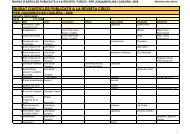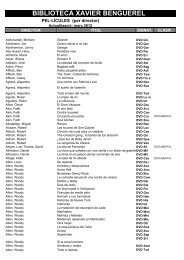Amphibians in the Region of Murcia (SE Iberian peninsula ... - Raco
Amphibians in the Region of Murcia (SE Iberian peninsula ... - Raco
Amphibians in the Region of Murcia (SE Iberian peninsula ... - Raco
You also want an ePaper? Increase the reach of your titles
YUMPU automatically turns print PDFs into web optimized ePapers that Google loves.
34 Egea–Serrano et al.IntroductionEnvironmental alteration as a consequence <strong>of</strong>anthropic activity is considered to have contributedto <strong>the</strong> decl<strong>in</strong>e <strong>of</strong> numerous amphibian populationsthroughout <strong>the</strong> world (Wake, 1991; Galán, 1997;Pechman & Wake, 1997; Marco, 2002a, 2002b). Acomplete <strong>in</strong>ventory <strong>of</strong> amphibian species present <strong>in</strong>a determ<strong>in</strong>ed territory, as well as its distributionrange, is <strong>of</strong> priority <strong>in</strong>terest. Such <strong>in</strong>formation wouldprovide a basic tool to establish <strong>the</strong> regional conservationstatus <strong>of</strong> <strong>the</strong> different species (UICN,2003) and consequently, to develop managementprogrammes to ensure <strong>the</strong>ir conservation (Palomo& Antúnez, 1992). Monitor<strong>in</strong>g efforts have enabledconservation status to be established on wide spatialscales (Pleguezuelos et al., 2002). Never<strong>the</strong>less,determ<strong>in</strong><strong>in</strong>g distribution and conservation statusat a regional scale is also necessary s<strong>in</strong>ce<strong>the</strong>se parameters can vary greatly for a given speciesfrom one region to ano<strong>the</strong>r (Gärdenfors et al.,1999, 2001).In addition to species conservation, ano<strong>the</strong>r target<strong>in</strong> conservation biology is to prioritize areas on<strong>the</strong> basis <strong>of</strong> <strong>the</strong>ir biological value (Su<strong>the</strong>rland, 2000),select<strong>in</strong>g those which show <strong>the</strong> highest priority.Such areas could represent a valuable tool forestablish<strong>in</strong>g conservation and management programmes.As regards amphibians, some studieshave established important areas for herpet<strong>of</strong>aunaconservation <strong>in</strong> <strong>the</strong> <strong>Iberian</strong> pen<strong>in</strong>sula (Santos et al.,1998; Mateo, 2002). These studies <strong>in</strong>clude <strong>the</strong><strong>Region</strong> <strong>of</strong> <strong>Murcia</strong> consider amphibian and reptilespecies toge<strong>the</strong>r, and no such studies establishpriority areas <strong>in</strong> this territory as a function <strong>of</strong> amphibianspecies present alone.The <strong>Region</strong> <strong>of</strong> <strong>Murcia</strong> <strong>in</strong> <strong>the</strong> sou<strong>the</strong>rn <strong>Iberian</strong>pen<strong>in</strong>sula is considered one <strong>of</strong> <strong>the</strong> most importantareas <strong>in</strong> <strong>the</strong> Mediterranean region for its amphibianspecies diversity and/or endemic amphibians(Bork<strong>in</strong>, 1999). It is characterized by an arid climate(Vidal–Abarca et al., 1992), which makes itunfavorable for amphibians due to hydrologicalstress and lack <strong>of</strong> breed<strong>in</strong>g habitats that suchclimatic conditions represent. Moreover, <strong>the</strong>se factorsmake <strong>the</strong> amphibian species present <strong>in</strong> <strong>the</strong><strong>Region</strong> <strong>of</strong> <strong>Murcia</strong> more vulnerable to land usechanges affect<strong>in</strong>g this area (Martínez & Esteve,2003) as <strong>the</strong>y <strong>in</strong>volve a severe habitat degradationprocess. Several studies deal<strong>in</strong>g with amphibianbiology and distribution (Miñano et al., 2003; Egea–Serrano, 2005; Egea–Serrano et al., 2005a, 2005b,2005c, 2005d, 2005e, 2005f) have been performed.Never<strong>the</strong>less, to date, <strong>the</strong>re has been no studyconcern<strong>in</strong>g <strong>the</strong> risk <strong>of</strong> ext<strong>in</strong>ction <strong>of</strong> amphibians <strong>in</strong><strong>the</strong> <strong>Region</strong> <strong>of</strong> <strong>Murcia</strong>.The objectives <strong>of</strong> <strong>the</strong> present study were todevelop a methodology based on <strong>the</strong> biological andecological constra<strong>in</strong>ts and distributions <strong>of</strong> amphibianspecies to evaluate <strong>the</strong> risk <strong>of</strong> ext<strong>in</strong>ction <strong>of</strong> <strong>the</strong>species present <strong>in</strong> <strong>the</strong> <strong>Region</strong> <strong>of</strong> <strong>Murcia</strong> and toestablish areas whose conservation should be consideredpriority.Material and methodsThe study area is restricted to <strong>the</strong> <strong>Region</strong> <strong>of</strong> <strong>Murcia</strong>(<strong>SE</strong> <strong>Iberian</strong> pen<strong>in</strong>sula). This territory <strong>in</strong>cludes most<strong>of</strong> <strong>the</strong> Segura River bas<strong>in</strong>, one <strong>of</strong> <strong>the</strong> most arid <strong>of</strong> <strong>the</strong><strong>Iberian</strong> pen<strong>in</strong>sula (Vidal–Abarca et al., 1987) and,probably, <strong>of</strong> Europe (Geiger, 1973). Eleven ecologicalsectors have been recognised <strong>in</strong> this bas<strong>in</strong> (Vidal–Abarca et al., 1990), most <strong>of</strong> <strong>the</strong>m exposed to a dry,hot and arid climate. However, dur<strong>in</strong>g <strong>the</strong> last threedecades land uses <strong>in</strong> <strong>the</strong> study area have been<strong>in</strong>creas<strong>in</strong>gly devoted to extensive agricultural irrigationpractices (Martínez & Esteve, 2003), while traditionalland uses (non–irrigated agricultural farms)are restricted to <strong>the</strong> northwestern region <strong>of</strong> <strong>the</strong> studyarea (Pérez & Lemeunier, 2003).Follow<strong>in</strong>g Andreone & Luiselli (2000) and Filippi& Luiselli (2000), 10 biological and ecologicalvariables were analysed. These variables <strong>in</strong>cludeaspects deal<strong>in</strong>g with <strong>the</strong> distribution, demography,ecology and taxonomy <strong>of</strong> <strong>the</strong> species present <strong>in</strong><strong>the</strong> study area. Data for <strong>the</strong>se variables wereobta<strong>in</strong>ed from <strong>the</strong> bibliography, as well as from <strong>the</strong>experience <strong>of</strong> <strong>the</strong> authors (table 1). Independentvariables were categorised, rang<strong>in</strong>g from <strong>the</strong> lowest(category 0) to <strong>the</strong> highest (categories 2, 3, 4,10, depend<strong>in</strong>g on <strong>the</strong> variable) risk <strong>of</strong> ext<strong>in</strong>ction.The variables considered <strong>in</strong> this study are relatedas follows, as well as <strong>the</strong>ir categories and <strong>the</strong>rationale for <strong>the</strong> choice <strong>of</strong> <strong>the</strong>se scores.Species presence <strong>in</strong> <strong>the</strong> <strong>Region</strong> <strong>of</strong> <strong>Murcia</strong>, basedon data presented by Egea–Serrano et al. (2005b,2005c): 0. Present <strong>in</strong> >50% <strong>of</strong> <strong>the</strong> study area surface;1. Present <strong>in</strong> 10–50%; 2. Present <strong>in</strong> 5–10%; 3.Present <strong>in</strong> 200 eggs/newborns; 1. 50–200; 2. 10–50; 3.



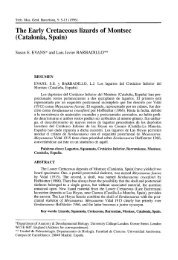
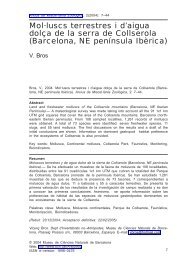
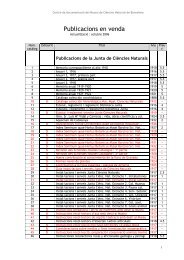
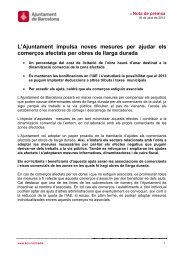
![[ pdf ] José Sanchis Sinisterra](https://img.yumpu.com/14886025/1/190x135/-pdf-jose-sanchis-sinisterra.jpg?quality=85)
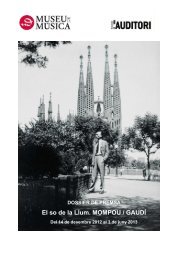
![[ pdf ] II Convenció Les veus de la gent gran 2004 - 2007](https://img.yumpu.com/14629010/1/190x182/-pdf-ii-convencio-les-veus-de-la-gent-gran-2004-2007.jpg?quality=85)

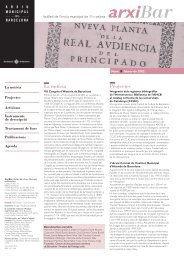

![[ pdf ] Material Escuela Pia Balmes](https://img.yumpu.com/14415004/1/184x260/-pdf-material-escuela-pia-balmes.jpg?quality=85)
